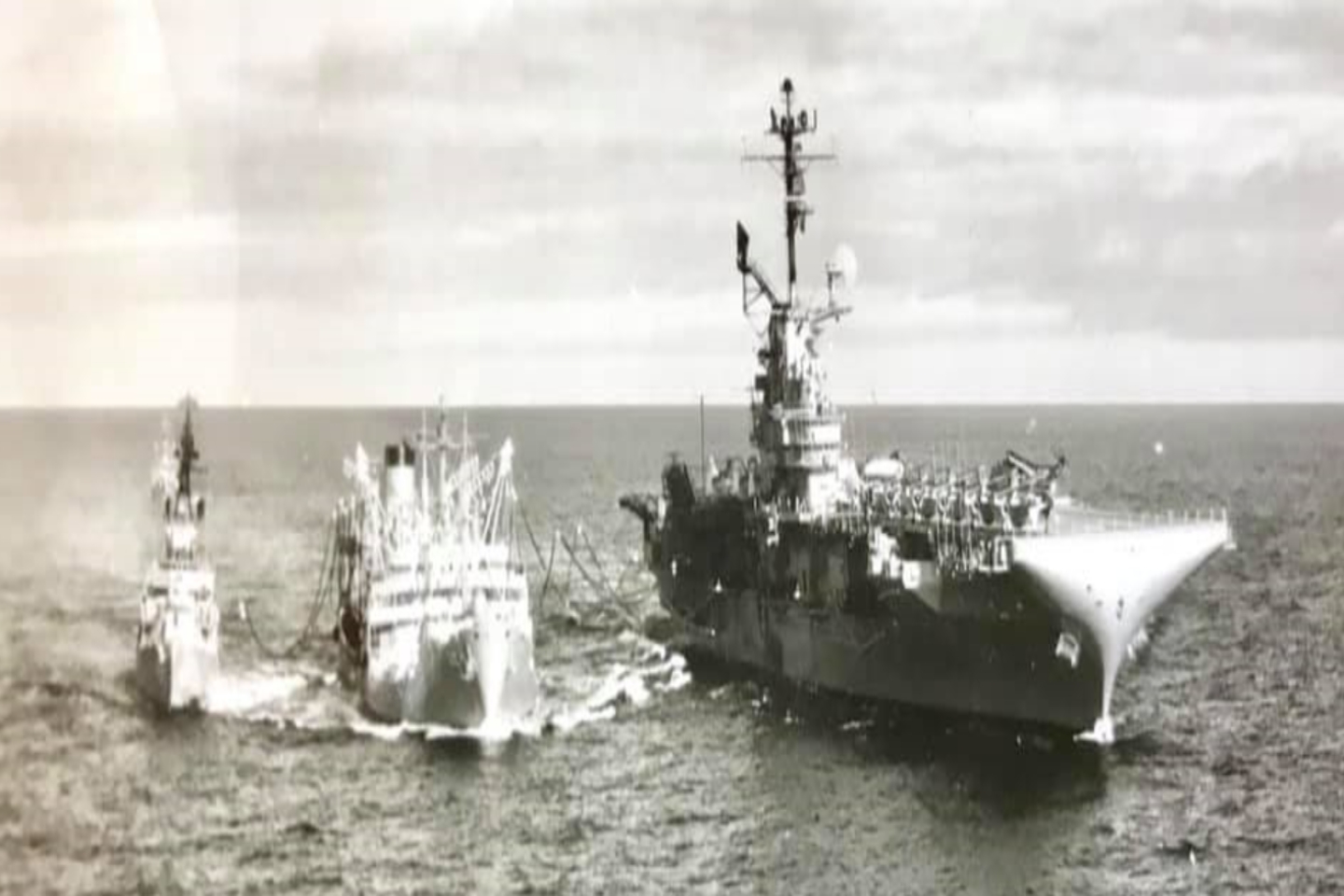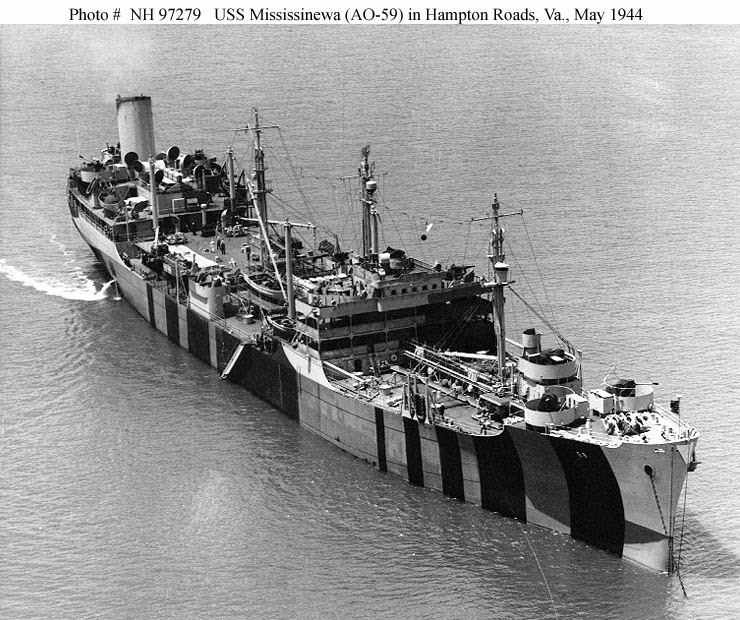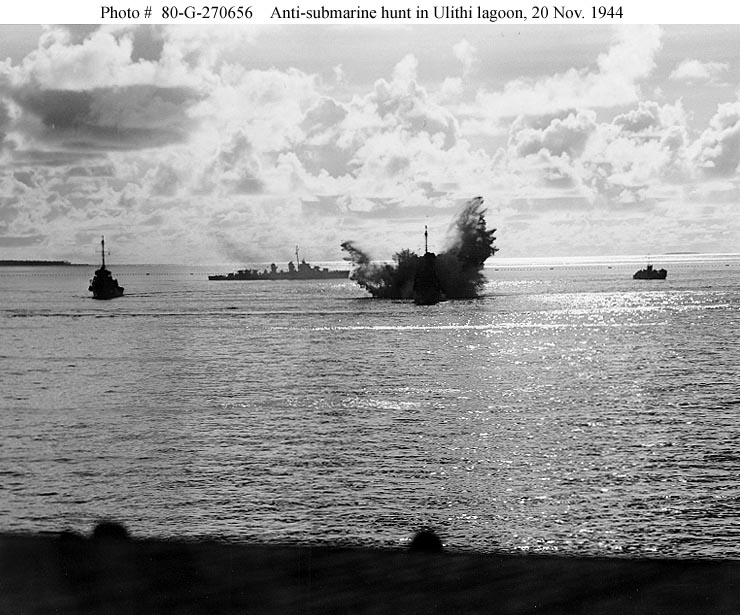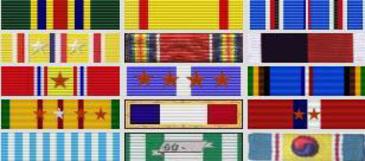Want to listen to a Jaunty Tune while browsing this age? Click the arrow on the video.

Caliente unrepping a carrier and a destroyer Jack Hughes (RMC, 1970 - 1972) and Jim Niquette (BM3, 1950 - 1954)
Cal Plaque, Fredericksberg, TX
THE USS CALIENTE
- Laid down as a Maritime Commission type (T3 S2-A3) hull, under Maritime Commission contract, MC Hull 71g, at Bethlehem Steel Shipyard, Sparrows, Maryland
- Launched 25 August 1943
- Sponsored Helen Essary
- Commissioned as the USS Caliente (AO-53) 12 October 1943
- Decommissioned 15 December 1973, Berth 63, Pier 6, U.S. Naval Shipyard, Long Beach, California
- Struck from the Naval Register 15 December 1973
- Transferred to the Maritime Commission for lay up in the National Defense Reserve Fleet
- Final Disposition, disposed of by the Maritime Administration (MARAD) by sale to National Metal & Steel Corp, 691 New Dock St. Terminal Island, California on 5 April 1974 for $426,819.01 - Ultimate fate unknown
- USS Caliente received 10 battle stars during World War II, four battle stars during the Korean War and eight combat campaign ribbons during the Vietnam War. The cal aslo received the Meritorious Unit Commendation, Battle Efficiency "E" and the green "C" for Communications Excellence.
- Reference; a) Department of the Navy Historical Center, Washington, Navy Yard, Washington, D.C. b) Fleet Disposal Branch Division of Reserve Fleet Maritime Administration 8 April 1974
The Cal has a Close Encounter
November 19/20, 1944; The USS Caliente pulled into Ulithi Atoll, Caroline Islands and was about to take her assigned berth in the harbor. When she approached the berth the USS Mississinewa (AO-59) was already tied up to the buoy assigned to the Cal. The Cal took another buoy. When the Cal crew awoke the next morning and was getting ready to go to their assigned duty stations a tremendous explosion occurred. A Japanese Kaiten (manned torpedo), the only one of five to be successful in their attack) hit the Mississinewa. The resultant fires reached the after magazine and caused yet another explosion to tear through the ship. The ship was abandoned and was soon enveloped in flames over 100 feet high. Although the fires were put out within fifteen minutes the Missisinewa slowly turned over and disappeared beneath the sea. 63 brave sailors, as well as the Kaiten pilot, lost their lives in this tragedy. The Kaiten got into the harbor when the gate across the entrance was lowered to let a cruiser out. This is probably the closest the Cal ever came to not being able to finish her distinguished career. Below is a video of Cal crew member Robert DeFine (QM1 1943-1945) telling the story at the Cal's 1st reunion, held in New York City, in 1989.
Pictures of the USS Mississinewa (AO-59)


_20_November_1944.jpg)
BATTLE STARS AND CAMPAIGN RIBBONS

WORLD WAR II
Marshall Island Operations - Spring 1944 Asiatic-Pacific Raids - Spring 1944
Hollandia Operation - Spring 1944 Marianas Operation - Summer 1944
Tinian Capture and Operation - Summer 1944 Western Caroline Islands Operation Summer/Fall 1944
Leyte Operations - Fall 1944 Luzon Operation - Winter 1944/1945
Okinawa Gunto Operation - Summer 1945 3rd Fleet Operations Against Japan - Summer 1945
KOREAN WAR
Communist China Spring Offensive UN Summer/Fall Offensive
Korean Defense - Summer/Fall 1952 Korea - Summer/Fall 1953
VIETNAM
Vietnam Defense Tet Counteroffensive
Vietnamese Counteroffensive - Phase IV Vietnamese Counteroffensive - Phase V
Tet/69 Counteroffensive Vietnam - Summer/Fall 1969
Sanctuary Counteroffensive Vietnamese Ceasefire
CLASS AND PHYSICAL CHARACTERISTICS
Class and type; Cimarron-class oiler
Displacement: 7,236 long tons/8,104 American tons light and 25,440 tons/28,493 American tons loaded
Length: 553 feet Beam: 75 Feet Draft 32 feet
Propulsion Geared turbines, twin screws
Speed: 18 knots (21 miles per hour)
Armament: One 5" 38 caliber gun; Four 3" 50 caliber guns; Four twin 40mm AA guns and Four twin 20mm AA guns - All but the Four 3" 50 caliber guns were removed from the Cal in the late 1950's
REFUELING CAPACITY
The USS Caliente carried approximately 4,000,000 gallons of Navy Standard Fuel Oil (NSFO), 1,500,000 gallons of jet fuel (JP-5) and 500,000 gallons of aviation fuel (Avgas). With that amount of volatile fuel and all the other activities taking place during ship-to-ship replenishment (unrep) the crew of the Cal had to maintain absolute vigilance to avoid dire consequences. While not a "glamorous", man of war, during the three wars she served in, the USS Caliente was critical to the wars' efforts. She enabled U.S. ground, air and sea service personnel to maintain battle readiness by supplying them with vital fuel and other supplies. During peace she conducted the same operations with the fleet, ensuring our countries' readiness for any occurrence. All the Cal's crews, from 1943 to 1973, served our country with the utmost of dedication and pride. If the Cal was unrepping an entire carrier group, the carrier would be along the port (left) side of the Cal and the other members of the carrier group would come along the starboard (right) side of the Cal. As the other ships in the group come and go the carrier would remain on station with the Cal the entire unrep. After unrepping a carrier group, the Cal was very often empty and liberty was at hand for the crew in the next refueling port - usually Subic Bay, (Olongapo) in the Philippines or Kaohsiung in Tawain. During an unrep in 1965 the Cal set a fleet record - pumping record of 10,000 barrels (42 gallons to the barrel) of oil per hour. A feat never before accomplished.
